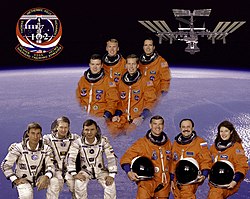Top Qs
Timeline
Chat
Perspective
STS-102
2001 American crewed spaceflight to the ISS From Wikipedia, the free encyclopedia
Remove ads
STS-102 was a Space Shuttle mission to the International Space Station (ISS) flown by Space Shuttle Discovery and launched from Kennedy Space Center, Florida. STS-102 flew in March 2001; its primary objectives were resupplying the ISS and rotating the Expedition 1 and Expedition 2 crews. It was Discovery's 29th flight. The first EVA performed on the mission, at eight hours and 56 minutes, held the title of the longest spacewalk ever undertaken until the 17th of December 2024 when it was surpassed by Cai Xuzhe and Song Lingdong during the Shenzhou 19 spaceflight.
Remove ads
Crew
Summarize
Perspective
Crew seat assignments
Unique to this flight, Shepherd, Gidzenko, and Krikalev were all seated together on the mid-deck in special "recumbent couches" that allowed them to stay in a laid-back reclining position during landing, instead of the usual upright seats. It was thought that after their four months in space, their bodies would be deconditioned and the recumbent position would minimize the impacts of returning to a gravity environment.[2] Because of the special seats, Thomas moved to the normal number 5 seat on the mid-deck to operate the side hatch as necessary. Future shuttle missions would not use the recumbent couches.
Remove ads
Spacewalks

- EVA 1
- Personnel: Voss and Helms
- Start: 11 March 2001, 05:12 UTC
- End: 11 March 2001, 14:08 UTC
- Duration: 8 hours, 56 minutes
- EVA 2
- Personnel: Thomas and Richards
- Start:13 March 2001, 05:23 UTC
- End: 13 March 2001, 11:44 UTC
- Duration: 6 hours, 21 minutes
Mission highlights
Space Station Assembly Flight ISS-5A.1 was the first use of the Multi Purpose Logistics Module (Leonardo) to bring supplies to the station. The steel modules were equipped with up to 16 International Standard Payload Racks for installation in the US Lab. Also carried an Integrated Cargo Carrier (ICC). The ICC had the External Stowage Platform-1 mounted on its underside. ESP-1 was placed on the port side of 'Destiny' as a storage location for ORUs. The mission also included two spacewalks to relocate the units carried up by the ICC to the Destiny module exterior.
Wake-up calls
NASA began a tradition of playing music to astronauts during the Gemini program, which was first used to wake up a flight crew during Apollo 15.[3] Each track is specially chosen, often by their families, and usually has a special meaning to an individual member of the crew, or is applicable to their daily activities.[3][4]
Remove ads
See also
References
External links
Wikiwand - on
Seamless Wikipedia browsing. On steroids.
Remove ads




